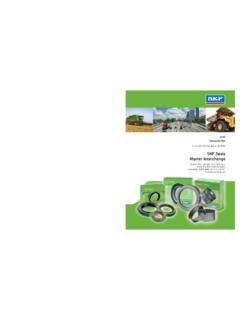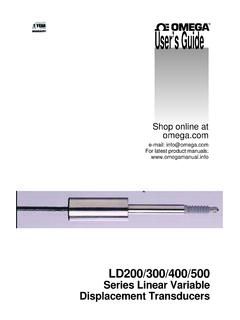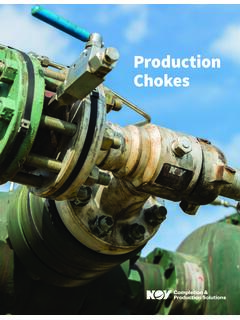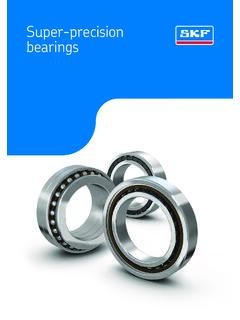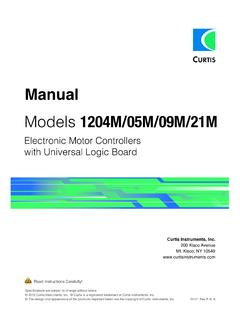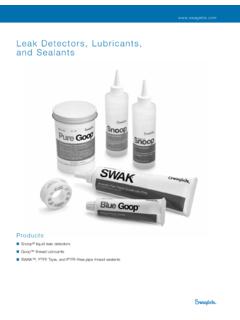Transcription of COMPOST QUALITY STANDARDS & GUIDELINES
1 COMPOST QUALITY in America COMPOST QUALITY . STANDARDS & GUIDELINES . Final Report by William F. Brinton, Project Manager Dec 2000. Prepared for: New York State Association of Recyclers 2000 - Woods End Research Laboratory , Inc. PAGE 1. COMPOST QUALITY in America COMPOST STANDARDS & GUIDELINES . Report to NYSAR3. by Woods End Research Laboratory, Inc. Markets for organic matter will not mature until farmers can be confident about the product they are buying.. Gary Gardner, World Watch Institute, 1998. SUMMARY: The concept of establishing STANDARDS specific to COMPOST and the promotion of QUALITY criteria in order to bolster the COMPOST industry and to aid growth of new markets has been slowly emerg- ing over nearly two decades through-out the western world. Recently, several European coun- tries have adopted specific many other countries are in the process of doing so. In the United States, efforts have been very scattered. The only existing QUALITY GUIDELINES specific to COMPOST are presently promulgated by such specific agencies as state DOT's, which have an interest in large-scale COMPOST usage.
2 This report examines the history of COMPOST appreciation, and particularly looks at the emerging awareness of the need to distinguish composts from other re-cycled wastes and common fertilizers. Without such distinguishing features, COMPOST sales may lag. This report also examines potential conflicts in setting new STANDARDS .. 2000 - Woods End Research Laboratory , Inc. PAGE 2. COMPOST QUALITY in America STRUCTURE AND INDEX OF THIS DOCUMENT. Page 3 STATUS OF NATIONAL COMPOST STANDARDS . Page 5 WHAT'S TO DECLARE IN COMPOST ? Page 9 EMERGENCE OF COMPOST QUALITY FOCUS. Page 9 SOURCE SEPARATION FOR LOW-CONTAMINANT COMPOST . Page 14 TECHNICAL COMPOST STANDARDS COMPARED. Page 16 COMPOST METAL STANDARDS . Page 19 OTHER PARAMETERS FOR COMPOST STANDARDS . Page 29 COMPOST STANDARDS . Page 30 COMPOST MATURITY STANDARDS IN US. Page 35 CONFORMITY vs. DISAGREEMENT IN EXISTING STANDARDS . Page 36 SUMMARY - REFERENCES. About the Title In some countries, composters seek to achieve certain QUALITY STANDARDS and in return receive QUALITY labels.
3 The certification and approval process defines and promotes COMPOST products as distinct from other soil amendments and fertilizers. Pictured are Seals from Italy, Austria, Germany, Holland, Belgium and the EEC. STATUS OF NATIONAL COMPOST STANDARDS . There is no simple way to give a summary concerning COMPOST QUALITY STANDARDS as they exist in the world, and how they arose. This document presents a variety of established and published STANDARDS . This study is based on gleaning conference proceedings, government reports, and private association GUIDELINES . The period of time covered in this review is roughly the last 10. years. Many countries are now beginning to routinely publish COMPOST GUIDELINES with implied stan- dards. Portions of these GUIDELINES are required by certain laws; others are obscure. This makes it hard to distinguish legal as in the case of legislative from voluntary systems of STANDARDS . The purpose of this report is, however, not to determine STANDARDS purely on a statutory basis, but to present an overview of such STANDARDS .
4 From this, we may hope to gain a better understanding of what common factors exist from which successful STANDARDS - whether mandatory or not - could be developed in America. A quick comparison of COMPOST STANDARDS of various countries shows Europe to be fairly well- developed, while the rest of the world, including the United States, lags significantly behind. Some of the causes of this difference are examined. One probable reason for the discrepancy seems to be political in nature. Also evident are differing scientific opinions regarding how tests on COMPOST should be conducted, or what constitutes critical levels in regards to environmental cleanliness of COMPOST . At a recent international trade meeting in Oxford England a Swiss speaker from a federally funded research institute remarked that if COMPOST was a world commodity, there is evidence that 2000 - Woods End Research Laboratory , Inc. PAGE 3. COMPOST QUALITY in America it would precipitate trade wars. He was referring to the sharp demarcations in how the product is defined , it at all.
5 The following table (Table 1) gives an overview of the existence of such defini- tions and STANDARDS in various countries, as given in the recent Vienna Conference Steps Towards a European COMPOST Directive (O-Com,1999). Table 1: Status of National COMPOST GUIDELINES (O-Com, 1999). Austria Fully established QUALITY assurance system Australia Comprehensive QUALITY criteria and analyzing methods. Belgium Established QUALITY assurance system in Flanders. Brussels and other regions may follow Flanders example. Canada Developed STANDARDS ; discussion re province specifics; trade- association QUALITY assurance system Denmark Recently implemented QUALITY assurance system with standardized product definition, analysis methods France Limited QUALITY criteria, research program underway for QUALITY management Greece Basic Solids Waste rules; no official COMPOST std. Germany Fully establish QUALITY assurance system;. Private Association maintains STANDARDS Hungary New COMPOST QUALITY Association Italy New decree in place for waste source separation.
6 Private COMPOST association formed to evaluate STANDARDS Japan New waste decree for waste separation; 2001- STANDARDS not developed Luxemburg Some COMPOST plants follow German QUALITY assurance system Netherlands Fully established QUALITY assurance and certificate system Norway COMPOST QUALITY studies underway;. criteria proposed for 3 QUALITY classes Spain COMPOST GUIDELINES established and proposal for QUALITY certi- fication system in the Catalonia region Sweden Recently implemented STANDARDS and COMPOST declaration system Switzerland Established minimum QUALITY STANDARDS United Kingdom Proposed QUALITY STANDARDS by private composting association USA COMPOST regulated under biosolids or fertilizer rule;. DOT use- STANDARDS in 13 states; Private association STANDARDS and GUIDELINES are promulgated by a variety of agencies. Indeed, difficulty exists in assessing COMPOST STANDARDS owing to the great range of sponsors, both private and public, that are evident. The following table gives regulations and labels that are presently available (Table 2).
7 2000 - Woods End Research Laboratory , Inc. PAGE 4. COMPOST QUALITY in America Table 2: Status of COMPOST QUALITY Seals by Country (Modified, after Centemero, 1999). Country Regulation or Guiding Rule QUALITY seal . Austria NORM S2220 1993. three classes of COMPOST - I, II, III. Australia Bureau of STANDARDS none Belgium Agricultural Agency two classes Canada Sludge Rule; Private Association (CCA) /. Denmark Danish EPA 1/06/2000 /. France Fertilizer Law /. Germany Federal BioWaste Decree (BioAbfallV) 1998. Federal Sludge Decree (KlarschlammV)1993;. Private COMPOST association (RAL). Hungary Private Association : 1999 /. Italy Fertilizer Law (3/98);. Private COMPOST association Luxemburg Draft Federal, taken from German RAL. Netherlands Waste Law, two classes: Clean COMPOST ;. Very Clean COMPOST Norway EPA /. Spain Bureau of Waste/Environment /. Sweden Swedish EPA /. Switzerland Federal STANDARDS Minimum QUALITY /. United Kingdom sludge law; private COMPOST Association /. USA Biosolids Rule governs all waste State Agencies with limited STANDARDS .
8 1 private label, no national seal 2000 - Woods End Research Laboratory , Inc. PAGE 5. COMPOST QUALITY in America WHAT'S TO DECLARE IN COMPOST ? Inorganic chemical fertilizers that carry a label by law must declare their N-P-K (nitrogen - phos- phorus - potassium) content according to rules established more than half a century ago. How- ever, COMPOST , a product that contains nutrients and organic matter, is not subject to any systematic rules for reporting its content, its qualities or potential risks. There are no labelling rules, and no published GUIDELINES to establish such rules, unless and only if such COMPOST pur- ports to be fertilizer. The idea that COMPOST is significantly different from inorganic fertilizers is not new; however, until recently the unique properties of COMPOST were overlooked and instead COMPOST has been gen- erally classified as a nutrient-poor "soil amendment". There have been recent changes, for exam- ple, within the last 10 years, the American Association of Plant Food Controllers (AAPFCO).
9 Altered its official definition of COMPOST with improved terminology. The special recognition of COMPOST as a potential fertilizer material predates the Wars, and was clearly defined as early as 1932 in the USDA publication Conservation of Fertilizer Materials from Minor Sources (Misc Pub 136). In the 1938 Yearbook of Agriculture Soils and Men the USDA stated "..there are many materials capable of being composted which possess fertilizer value". This government publication clearly enunciated the view that "Instead of burning or discarding these materials, it is advisable to make a COMPOST pile". (USDA, 1938). After WWII, with the advent of cheap fertilizers, composting as a potential agricultural practice fell into disuse or neglect. With the rise of the organic farming movement, however- which also pre- dates the Wars but only flourished after WWII- composting became associated with "back to the land movement". As recently as 1980, AAPFCO appeared to pan organic in its definition in the Farm Chemicals Handbook (FCH, 1980).
10 But the startling publication in 1975 by Washington University's Center for the Biology of Natural Systems (CBNS, 1975), showing favorable compar- isons of farms that used only manures and composts as compared to standard chemical prac- tice, began a turning of events that refocused the awareness of the value of soil organic matter and composts. This culminated in an official USDA study "Report and Recommendations on Organic Farming" under Bob Bergland, Secretary of Agriculture (1980) in which perhaps for the first time since 1938 the properties of organic matter and COMPOST were officially lauded. This study reiterated a long known definition of COMPOST : "An ancient practice whereby farmers convert organic waste into useful organic soil amendments that provide nutrients to crops and enhance the tilth, fertility, and productivity of soils" (USDA, 1980). Simultaneous to these events, USDA's Beltsville Agricultural Experiment Station published the first official guideline on composting sewage sludge, originating the Beltsville aerated pile method and providing GUIDELINES for use of composted sludge in agriculture (USDA, 1980).

